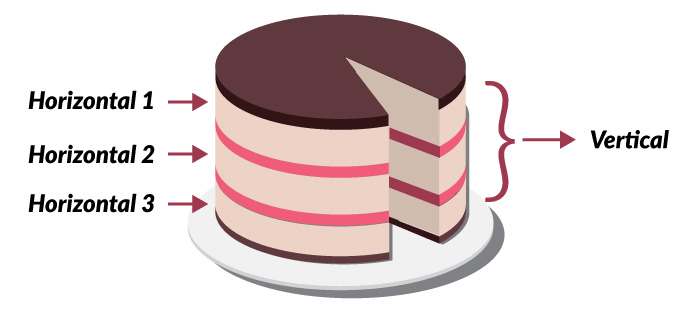What Is a Vertical Slice?
A vertical slice is a project management technique that emphasizes delivering a fully functional piece of a project, encompassing all layers of the application stack. Unlike traditional development methods that build software layer by layer (horizontal slicing), vertical slicing focuses on creating a cross-sectional slice through the entire structure of the project. This approach ensures that each feature or functionality is developed and delivered end-to-end in a single iteration.

In the context of software development, a vertical slice includes everything from the user interface to the backend services and database interactions. This method allows teams to demonstrate progress across all components of a project, providing a tangible milestone or benchmark. By delivering a complete, albeit small, piece of functionality, teams can validate, prioritize, and refine their work more effectively.
Originating in the video game industry, the concept of a vertical slice has been widely adopted in Agile methodologies. It enables cross-functional teams to work collaboratively, ensuring that each iteration of the project is both functional and valuable. This approach not only enhances team collaboration but also streamlines the development process, making it more efficient and responsive to changes.

Overall, a vertical slice is a powerful tool for managing complex projects, offering a clear and practical way to track progress and deliver high-quality results incrementally.
Benefits of the vertical slice approach
The vertical slice approach offers numerous advantages that can significantly enhance the development process. Here are some key benefits:
- Comprehensive Progress Demonstration: By delivering a fully functional piece of the project, a vertical slice provides a clear and tangible demonstration of progress across all components. This holistic view helps stakeholders understand the project’s current state and future potential.
- Early Validation: Vertical slicing allows for early testing and validation of features. This means potential issues can be identified and addressed sooner, reducing the risk of costly rework later in the development cycle.
- Enhanced Team Collaboration: Since vertical slices require cross-functional teams to work together, this approach fosters better communication and collaboration among team members. Each team member contributes their expertise to deliver a complete feature, promoting a more integrated and cohesive workflow.
- Incremental Delivery: Vertical slicing aligns well with Agile methodologies, enabling incremental delivery of end-to-end functionality. This iterative process allows for continuous feedback and improvement, ensuring the final product meets user needs and expectations.
- Improved Prioritization: By focusing on delivering fully functional features, teams can better prioritize their work based on user value and business impact. This ensures that the most critical features are developed and delivered first, providing maximum value to users and stakeholders.
- Reduced Complexity: Vertical slices break down the project into manageable pieces, reducing the complexity of the development process. This makes it easier to track progress, manage dependencies, and ensure that each feature is fully integrated and functional.

Overall, the vertical slice approach offers a structured and efficient way to develop and deliver high-quality software, making it a valuable technique for any development team.
Vertical slice vs. Horizontal slice
When discussing the vertical slice approach, it is essential to compare it to the traditional method of horizontal slicing. Horizontal slice, often used in software and game development, involves building the application layer by layer. This means that developers work on one layer at a time, such as the user interface, business logic, or data access layer, before moving on to the next.

Here are some key differences between the two methodologies:
- Scope of Work: Horizontal slicing breaks down the project into layers, while vertical slicing breaks it down into features that encompass all layers.
- Progress Demonstration: Vertical slicing provides a clear demonstration of progress across all components of a project, whereas horizontal slicing may not show tangible progress until all layers are integrated.
- Team Collaboration: Vertical slicing encourages cross-functional team collaboration, as it requires input from various disciplines (e.g., UI/UX designers, backend developers, QA testers) to complete a feature. Horizontal slicing often leads to siloed work, with each team focusing on their specific layer.
- Risk Management: By delivering fully functional features incrementally, vertical slicing helps identify and mitigate risks early in the development process. Horizontal slicing may delay the discovery of integration issues until later stages.
- Customer Feedback: Vertical slicing allows for early and continuous feedback from stakeholders and end-users, as they can interact with complete features. Horizontal slicing may delay feedback until the entire application is assembled.
Overall, while horizontal slicing has its merits, the vertical slice approach offers a more holistic and agile way to develop software and games, ensuring that each iteration delivers tangible value and aligns with the project’s goals.
Applications of vertical slice
The vertical slice methodology has a wide range of applications across various industries, particularly in software and game development. Here are some key applications:
- Game Development: In game development, vertical slicing is used to create feature-based iterations of the game. This approach allows developers to validate, prioritize, and deliver game features in an agile manner. By focusing on a small, fully functional segment of the game, teams can quickly identify and address issues, ensuring a smoother development process.
- Software Development: Vertical slicing is a popular technique in agile software development. It involves delivering end-to-end functionality incrementally, which helps in maintaining a high level of quality and usability throughout the development process. This method is particularly useful for complex applications where different layers (e.g., presentation, business logic, data access) need to be developed and tested together.
- Project Management: As a project management technique, vertical slicing helps in setting clear milestones and benchmarks. By demonstrating progress across all components of a project, teams can ensure that each part of the project is aligned and integrated, reducing the risk of bottlenecks and miscommunication.
- Vertical Slice Architecture: This approach organizes code by feature rather than by layer, allowing for more maintainable and scalable applications. Each feature encompasses everything it needs, from API endpoints to data access, making it easier to manage and update individual features without affecting the entire application.
By adopting the vertical slice methodology, teams can enhance collaboration, streamline the development process, and deliver high-quality products more efficiently.
Vertical Slice in Game Development: Key Concepts and Importance

In game development, a vertical slice serves as a comprehensive milestone that demonstrates progress across all components of the project. It is essentially a fully functional segment of the game that includes gameplay mechanics, graphics, sound, and user interface elements. This method allows developers to validate and refine the core gameplay experience early in the development cycle.
Key concepts of a vertical slice include:
- End-to-End Functionality: A vertical slice encompasses all aspects of the game, providing a complete, playable segment that can be tested and evaluated.
- Cross-functional collaboration: This approach necessitates collaboration among different teams, including designers, developers, artists, and testers, ensuring that all aspects of the game are aligned and integrated.
- Incremental Development: By focusing on delivering a fully functional piece of the game, developers can incrementally build and refine the game, reducing the risk of major issues arising late in the development process.
- Agile Methodology: Vertical slicing aligns with Agile principles, promoting iterative development and continuous feedback, which are crucial for adapting to changes and improving the game based on player feedback.
Vertical slice in game development provides a tangible proof of concept that can be used to secure funding, attract stakeholders, and guide the development process. By delivering a complete, polished segment of the game early on, developers can identify and address potential issues, streamline workflows, and ensure that the final product meets the desired quality standards.
The Importance of Vertical Slice in Game Development
The concept of a vertical slice is pivotal in game development, serving as a comprehensive milestone that demonstrates progress across all components of a project. This approach offers several critical advantages:
Enhancing Team Collaboration
Here are some key ways in which vertical slicing enhances team collaboration:
- Cross-Functional Teams: Vertical slicing necessitates the formation of cross-functional teams, where members from different disciplines (e.g., designers, developers, testers) work together on a single feature. This fosters a deeper understanding of each other’s roles and challenges, leading to more cohesive teamwork.
- Shared Goals: With a vertical slice, the entire team focuses on a common goal—delivering a complete, functional feature. This shared objective aligns the team’s efforts and reduces the likelihood of siloed work, where team members only concentrate on their specific tasks without considering the bigger picture.
- Improved Communication: Regular interactions and collaborations among team members are essential for the successful implementation of a vertical slice. This continuous communication helps in identifying and resolving issues promptly, ensuring that the feature is developed smoothly and efficiently.
- Faster Feedback Loops: By delivering a fully functional piece of the game in each iteration, teams can quickly gather feedback from stakeholders and end-users. This rapid feedback loop allows for timely adjustments and improvements, enhancing the overall quality of the game.
- Enhanced Problem-Solving: Working on a vertical slice requires team members to think holistically and consider how different components of the game interact with each other. This comprehensive approach to problem-solving leads to more innovative and effective solutions.
Streamlining the Development Process
By focusing on end-to-end functionality, vertical slicing allows teams to:
- Reduce Integration Issues: Since each slice is a fully functional piece, integration problems are minimized, leading to smoother and faster development cycles.
- Enhance Flexibility: Teams can quickly adapt to changes and new requirements, as each slice can be adjusted independently without affecting the entire project.
- Improve Testing Efficiency: Testing can be performed on complete features rather than isolated components, ensuring that all parts work together seamlessly.
- Accelerate Delivery: With a focus on delivering functional features, the time to market is reduced, allowing for quicker feedback and iteration.
Exploring Vertical Slice Architecture: Structuring Your Game Development Process
In the realm of game development, Vertical Slice Architecture (VSA) offers a transformative approach to structuring your development process. Unlike traditional layered architectures that separate code into horizontal layers such as Presentation, Application, and Domain, VSA organizes code by feature. This method ensures that each feature encompasses everything it needs, from API endpoints to data access, creating a more cohesive and manageable codebase.

Here are some key aspects of implementing Vertical Slice Architecture in your game development process:
- Feature-Centric Development: VSA focuses on developing features end-to-end. Each feature is treated as a self-contained unit, which includes all necessary components such as UI, business logic, and data access. This approach allows for more focused and efficient development cycles.
- Enhanced Modularity: By organizing code around features, VSA promotes modularity. This makes it easier to manage, test, and maintain individual features without affecting the entire codebase. It also facilitates parallel development, as different teams can work on separate features simultaneously.
- Improved Agility: VSA aligns well with Agile methodologies. It allows for incremental delivery of fully functional features, enabling continuous feedback and iteration. This agility helps in quickly adapting to changes and improving the overall quality of the game.
- Customization and Flexibility: VSA provides the flexibility to customize approaches for each feature. Developers can utilize various tools, patterns, or paradigms tailored to the specific needs of a feature, without enforcing a uniform coding style across the entire application.
To effectively implement Vertical Slice Architecture, consider the following best practices:
- Define Clear Boundaries: Clearly define the boundaries of each feature to ensure that it remains self-contained. This helps in maintaining the integrity and independence of each feature.
- Utilize Cross-Functional Teams: Assemble cross-functional teams that include members with diverse skill sets. This ensures that all aspects of a feature, from design to deployment, are covered within the team.
- Leverage Modern Tools and Patterns: Utilize modern tools and patterns such as the MediatR library and CQRS (Command Query Responsibility Segregation) to streamline the development process and enhance the maintainability of your codebase.
By adopting Vertical Slice Architecture, game developers can achieve a more organized, efficient, and agile development process. This approach not only enhances the quality of the final product but also fosters better collaboration and innovation within development teams.
GIANTY has recently demonstrated its expertise in the full development cycle by successfully guiding a product from the Prototype stage to the Vertical Slice stage. Our team of seasoned professionals meticulously refined the initial concept, ensuring that the core mechanics, art style, and overall vision were not only brought to life but also honed to meet high industry standards. This achievement underscores our capability to translate innovative ideas into polished, functional segments that capture the essence of the final product, showcasing our commitment to quality and creativity at every stage of development.











